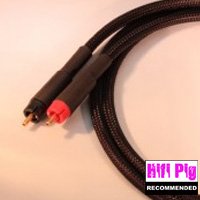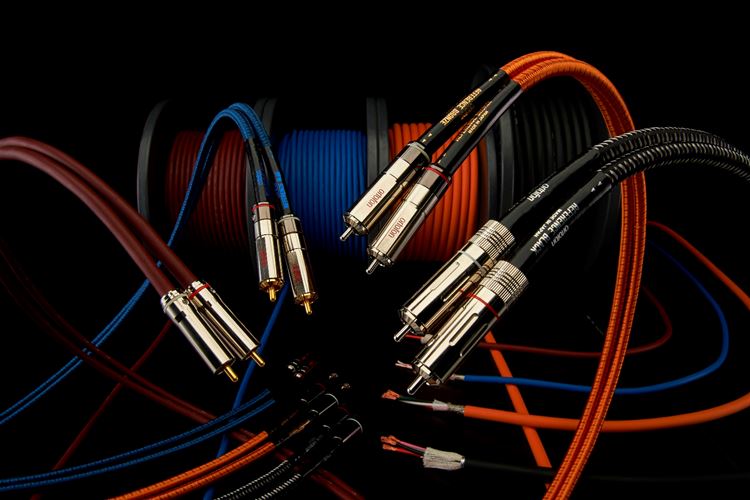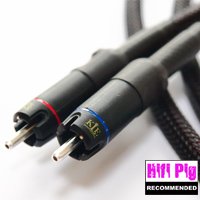…. & a quick look at ‘Fidelity Io’ Cables as well!
Reference Fidelity Components (RFC) is a small and fairly new company based in Gloucestershire, UK. In fact, the proprietor is Hifi Pig’s very own Paul. 
“What? Blatantly biased!”, I hear the pundits scream. Well, no, that’s not my job – I’m here to give Hifi Pig’s readers a fair and honest assessment of the equipment and music I review, and that is exactly what I will do. In fact, I suspect I will be rather harder on the RFC cables than would otherwise be the case – overcompensating, as it were.
I had an interesting session the other day, playing compare & contrast with the RFC Reference Mercury (£165 for a 1m pair) and the lower cost RFC Fidelity Io cables (£75 for a 1m pair). Somewhat surprisingly, the more costly Mercury didn’t have it all its own way!
The Mercury is the mid-price of three in RFC’s top of the line Reference series of cables.
Construction quality was excellent, RCA plugs were of good quality on the Io, and the Mercury used very impressive top of the line Cardas connectors; a definite touch of bling there! Reference Fidelity components are insistent that connector quality is crucial to getting the most out of cables – I must admit I’d be curious to hear the same cables with different plugs on, but sadly I’ve not been able to do that yet. Call me agnostic on the subject.
OK, let’s take a closer look at the Reference Mercury cables themselves. The conductors used are described by RFC as being “Furutech Hyper-balanced μOFC twin conductor (80pcs 0.18mm), double shielded in cotton spacer/damping, polyethylene low loss dielectric and flexible 9mm OD ultra-flexible PB free pvc jacket, finished in polyester weave protective outer jacket”. Oh, and the Cardas connectors are made of Eutectic Brass.
Blimey – I hope that means more to you than it does to me. RFC are clearly somewhat obsessed by the physics of cable technology and when Paul talks about it to me I do wonder if he notices that my eyes glaze over! Anyway, the cable is quite thick (a cm or so) but fairly flexible and there should be no problems linking components with this cable.
The sound, what about the sound?
Fair comment. Let’s see what happened.
I started off with the cheaper Fidelity Io cables on a CD of Mahler’s 3rd symphony – Tennstedt’s EMI studio recording. This is a superb audiophile quality production and a great test for any audio equipment. The opening movement starts with a massive brass fanfare – a real challenge for treble and midrange quality – and then a roll on a big bass drum where there’s real deep bass power, slam and heft there when the audio system is up to it.
Bass was astonishingly good with the Io cables. I mean quite exceptional. Bass freaks will really enjoy this cable! A bit emphasised? – hmm, possibly. But a huge amount of fun! Further up the frequency range some treble emphasis and lower treble grain were noticeable – Images were a little blurred together, making for an immersive rather than a precise presentation.
Yep, I enjoyed the Io, even if it was somewhat flawed. A real bargain cable for rock music, for example, but not so good for acoustic music, in my opinion.
Swapping over to the more expensive Reference Mercury was something of a revelation in many ways – a definite “wow” moment. My written notes start with “OMG presence!” The music suddenly gained a huge amount of in-room thereness, palpability and sheer transparency and midrange definition. Imaging was more precise, but more spacious too. Damn, you do get what you pay for sometimes. And the treble emphasis and grain heard with the Io was completely gone. But – you probably guessed it – the bass lost a bit of definition and slam compared to the funky Io cables. Was the Mercury just more natural in the bass? Mmmm, no, I don’t honestly think so. It had lost a bit of definition and heft. It wasn’t bad, far from it – it was tuneful and fruity, and you could definitely hear what the musicians were up to – but on going back to the Io the bass was more defined, controlled and more powerful feeling.
No doubt about it, though, overall the Mercury was a substantial step up, and I consider it an excellent cable.
The astonishing guitar playing of Blues-ist Melvin Taylor & The Slack Band was wonderfully caught. The raunchy power and excitement of the playing proved a huge amount of fun. I’ve not heard this disc sound better than with the Reference Mercury.
Toward the end of the listening session I slipped volume1 of Naxos’ wonderful series of solo lute sonatas by Silvius Weiss into my CD player. Sigh … bliss. The delicacy, image focus and realistic portrayal of the ambiance of the recording space was a joy to behold. And the superb lute playing of Robert Barto had a musical fluidity and natural ease that I have not heard before. To be blunt, it was wonderful, and my system is noticing the lack now that the Mercury cables have gone. Damn, that’s one of the downsides of reviewing hifi, I guess!
Could the Mercury be better? Well, yes, of course. But then there’s the top of the line Reference Venus to be had. I dare say that brings you one step closer to the ultimate musical experience. Maybe I’ll try that one day.
Review system: MBL 116F speakers, Parasound Halo A21 power amp, Krell KRC-3 pre-amp, Resolution Audio CD50 CD Player, PS Audio Power Plant Premier mains regenerator. Speaker cables Acoustic Zen Satori or Cable Talk 3.
Interconnect cable references: a 4N pure silver interconnect with Neutrik RCAs which had undergone a cryogenic freezing treatment (£40 for a 0.5m pair), and also Connex Audio ‘Ultimate Silver’ cables (£175 a 1m pair).
Want to read more hifi reviews?
















































































































































































You must be logged in to leave a reply.